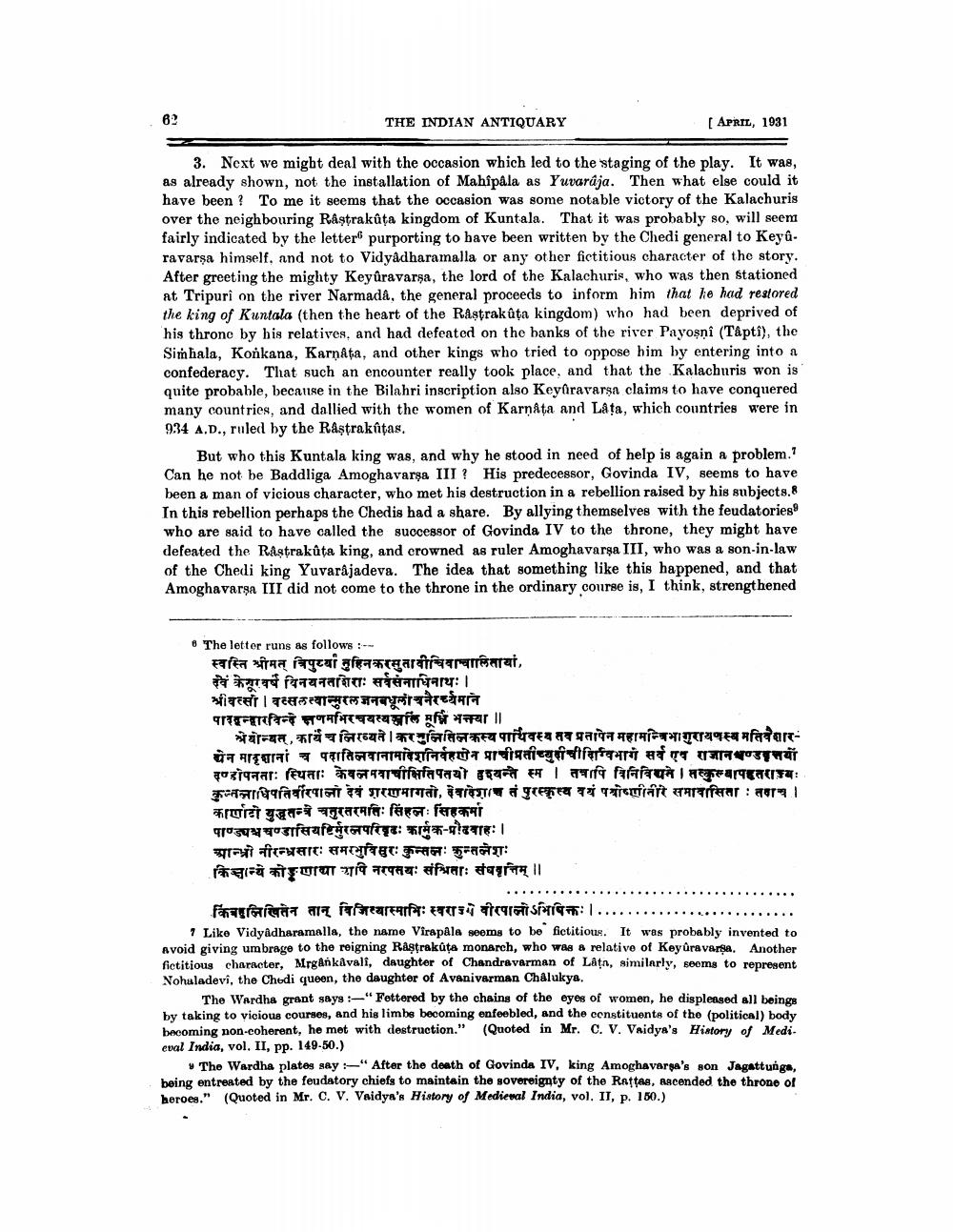________________
62
THE INDIAN ANTIQUARY
[APRIL, 1931
3. Next we might deal with the occasion which led to the staging of the play. It was, as already shown, not the installation of Mahîpâla as Yuvaraja. Then what else could it have been? To me it seems that the occasion was some notable victory of the Kalachuris over the neighbouring Râstrakûta kingdom of Kuntala. That it was probably so, will seem fairly indicated by the letter purporting to have been written by the Chedi general to Keyûravarsa himself, and not to Vidyadharamalla or any other fictitious character of the story. After greeting the mighty Keyûravarsa, the lord of the Kalachuris, who was then stationed at Tripuri on the river Narmada, the general proceeds to inform him that he had restored the king of Kuntala (then the heart of the Rastrakuta kingdom) who had been deprived of his throne by his relatives, and had defeated on the banks of the river Payoşnî (Tâptî), the Simhala, Konkana, Karnata, and other kings who tried to oppose him by entering into a confederacy. That such an encounter really took place, and that the Kalachuris won is quite probable, because in the Bilahri inscription also Keyûravarsa claims to have conquered many countries, and dallied with the women of Karnata and Lata, which countries were in 934 A.D., ruled by the Râştrakutas.
But who this Kuntala king was, and why he stood in need of help is again a problem." Can he not be Baddliga Amoghavarsa III? His predecessor, Govinda IV, seems to have been a man of vicious character, who met his destruction in a rebellion raised by his subjects.8 In this rebellion perhaps the Chedis had a share. By allying themselves with the feudatories? who are said to have called the successor of Govinda IV to the throne, they might have defeated the Rastrakûta king, and crowned as ruler Amoghavarsa III, who was a son-in-law of the Chedi king Yuvarâjadeva. The idea that something like this happened, and that Amoghavarsa III did not come to the throne in the ordinary course is, I think, strengthened
6 The letter runs as follows:--
zalta wing fageni glasgardisarankarat, केयूर वर्ष विनयनतशिराः सर्वसेनाधिनाथः ।
श्रीवत्सी | वसलत्वान्सुरल जनबधूलो चनैरर्थ्यमाने पारद्वन्द्वारविन्दे क्षणमभिरचयत्यञ्जलिं मूर्ध्नि भक्त्या ||
श्रेयोन्यत् कार्य चलिरव्यते । कर खुलिसिन कस्य पार्थिवस्थ तव प्रतापेन महामन्त्रि भा गुरायणस्य मतिवैशारयेन मादृशानां च पदातिलवानामादेशनिर्वहणेन प्राची प्रतीयुतीची विग्विभागं सर्व एव राजानश्चण्डवृलयों इण्डोपनताः स्थिताः केवलमवाचीक्षितिपतयो दृश्यन्ते स्म । तत्रापि विनिविद्यते । सस्कुल्बापहतराज्यः कुन्ननाधिपतिर्वारपालो देवं शरणमागतो, देवादेशाच्च तं पुरस्कृत्य वयं पयोष्णीनीरे समावासिता : तवाच । ortgageen for few पाण्ड्यश्वचण्डासियष्टिर्मुरनपरिवृढः कार्मुक प्रौढवाहः ।
með ferare: anchftge: Fran: HaЯn:
किचान्ये कोणाया अपि नरपतयः संश्रिताः संघट्टत्तिम् ||
किंबहु लिखितेन तान् विजित्यास्माभिः स्वराज्ये वीरपानोऽभिषिक्तः । ...
7 Like Vidyadharamalla, the name Virapâla seems to be fictitious. It was probably invented to Avoid giving umbrage to the reigning Råstrakuta monarch, who was a relative of Keyûravarṣa. Another fictitious character, Mrgankavali, daughter of Chandravarman of Lâța, similarly, seems to represent Nohaladevi, the Chedi queen, the daughter of Avanivarman Chalukya.
The Wardha grant says:-"Fettered by the chains of the eyes of women, he displeased all beings by taking to vicious courses, and his limbs becoming enfeebled, and the constituents of the (political) body becoming non-coherent, he met with destruction." (Quoted in Mr. C. V. Vaidya's History of Medieval India, vol. II, pp. 149-50.)
The Wardha plates say :-" After the death of Govinda IV, king Amoghavarsa's son Jagattunga, being entreated by the feudatory chiefs to maintain the sovereignty of the Rattas, ascended the throne of heroes." (Quoted in Mr. C. V. Vaidya's History of Medieval India, vol. II, p. 150.)




